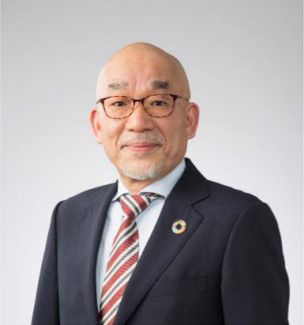
Eiji Fukunishi
Vice President and Executive Officer, President of Mining Business Unit
- October 1982
Joined Hitachi Construction Machinery - April 2016
General Manager, Sales Promotion Dept., Customer Support Div., Life Cycle Support Operations Div., Marketing Group - April 2017
Director and CEO, PT Hexindo Adiperkasa Tbk - April 2021
Executive Officer, the Company General Manager, Life Cycle Support Operations Div. - April 2022
President, Spare Parts and Service Business Unit - April 2023
Vice President and Executive Officer (to present) - April 2024
President, Mining Business Unit (to present)
Becoming a True Solutions Provider
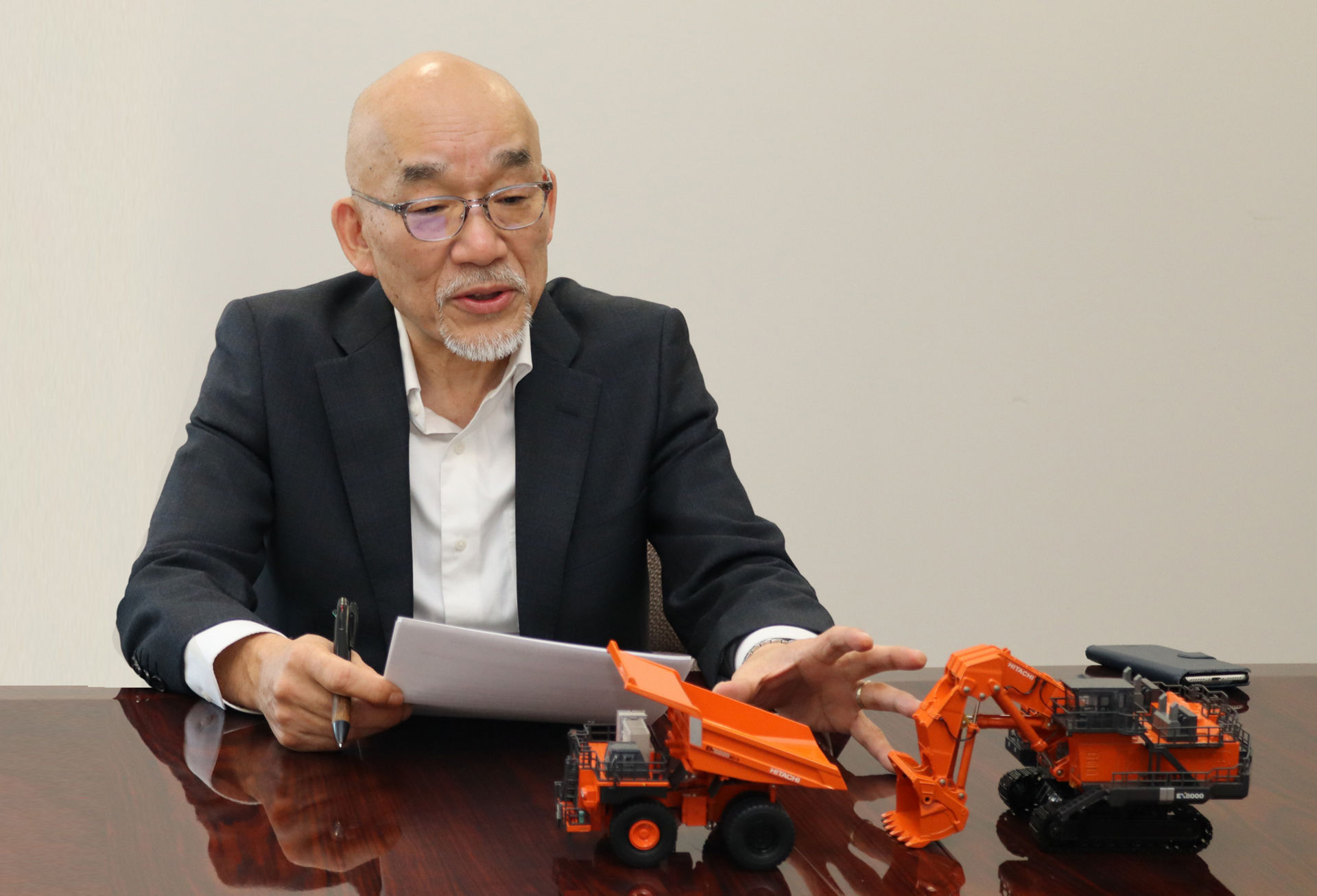
In its medium-term management plan, Hitachi Construction Machinery aims to grow as a true solutions provider by delivering innovative solutions. Could you please tell us about the background behind the demand for such solutions in the field of mining?
Due to changes in society, technology, and the economic environment, the mining market is becoming very different from before. We are seeing increasing demand for improved safety at mining sites, digitalization and automation for more efficient management, and electrification technologies to achieve decarbonization. Our customers require us to provide comprehensive solutions for mining operations to solve such management challenges.
In order to do so, our mining business is involved in a wide range of activities, which include the sales of both tangible products and intangible services. That is why we announced a policy of growing as a true solutions provider by delivering innovative solutions.
Ever since developing the first hydraulic excavator based on pure domestic technologies in 1965, we have achieved excellent results with large hydraulic excavators in the field of mining. After acquiring Canadian company Euclid in 1998, we also started providing dump trucks (the company is now known as Hitachi Construction Truck Manufacturing Ltd.) We then acquired Canadian company Wenco, which creates mining fleet management systems, in 2009, American company H-E Parts, which is a supplier of mining parts, remanufactured components, in 2016, and Australian company Bradken, which provides parts and solutions for mining machinery, in 2017. This has enabled us to expand our business to the pit phase*1 and plant phase*2 so that we can provide total solutions to our customers.
*1 The phase for excavating ore from the deposit where it is distributed.
*2 The phase for separating useful minerals from mined ore.
How do you plan to coordinate with external partners?
One pressing management issue for our customers is ESG (Environment, Society, and Governance). In order to reduce CO2 emissions, we have entered a partnership with domestic suppliers and ABB to work toward electrification. We are also collaborating with leading companies in the field of automation systems and digitalization that will enable us to save energy. In 2024, we also invested in Australian company Envirosuite, which offers real-time remote monitoring and prediction of environmental indicators at mining sites, such as air quality, dust, and noise. In the future, we plan to incorporate Envirosuite technology in our ConSite Mine service solution and other products such as mine management systems from Wenco in order to enhance functionality.
We will continue to provide the open solutions that our customers need by expanding partnerships with leading domestic and international companies with diverse technology and expertise in various industries.
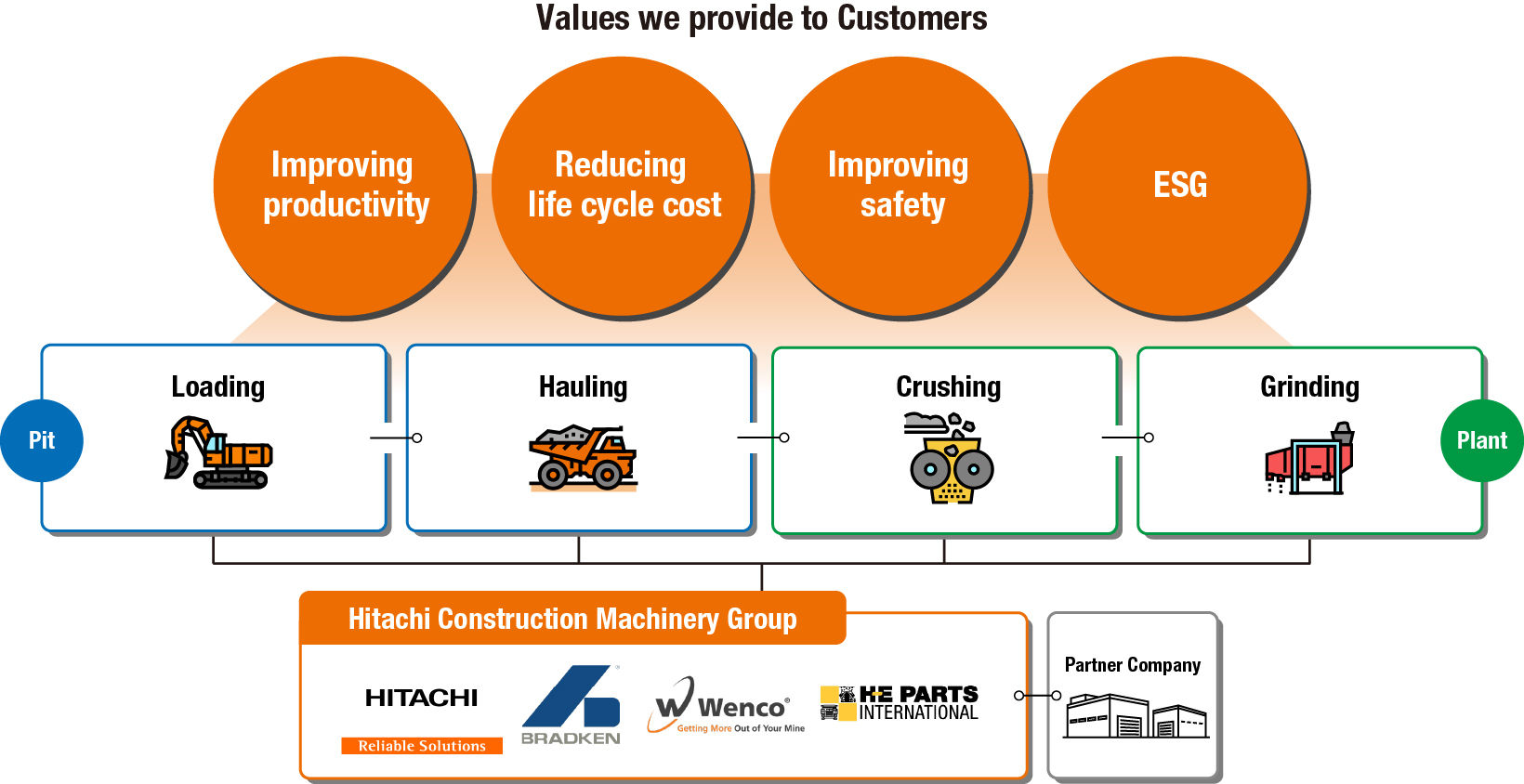
Four Kinds of Value Provided to Our Customers
Hitachi Construction Machinery defines four kinds of value that it provides to its customers, which are improved safety, improved productivity, reduced lifecycle costs, and ESG. Could you please explain in detail?
In order to solve the issues of our customers, we have provided total services via a value chain encompassing various fields including products themselves, parts and services, and digital solutions.
Improved safety involves automation, autonomization, and labor saving. We have developed a unique Autonomous Haulage System (AHS), which entered commercial service in 2024 after a six year period of testing at mining sites in Australia. One feature of the system is its ability to operate at sites where there are both manned vehicles and unmanned vehicles. We are also developing and testing remote operation and automatic excavation with hydraulic excavators.
In terms of improved productivity and reduced lifecycle costs, we enhance our after-sales service in order to reduce such costs as we improve product functionality. In particular, our more than 20 years of experience with remote monitoring and AI analysis in ConSite Mine enables us to notify customers of the appropriate timing for performing maintenance in accordance with the state of operation. We also focus on refurbishing parts in order to both reduce lifecycle costs and achieve a circular economy that reduces waste.
In terms of ESG, we started testing a fully electrified rigid dump truck without an engine at mining sites in Zambia in June 2024, which is a world-first. The mining process accounts for approximately half of the CO2 emissions at mining sites, and many of the vehicles in operation are rigid dump trucks. By fully electrifying a rigid dump truck, we can save about 1.2 million liters of diesel fuel per truck every year, which equates to reducing CO2 emissions by approximately 3,000 tons. We hope to continue providing solutions that consider the environment while also improving productivity.
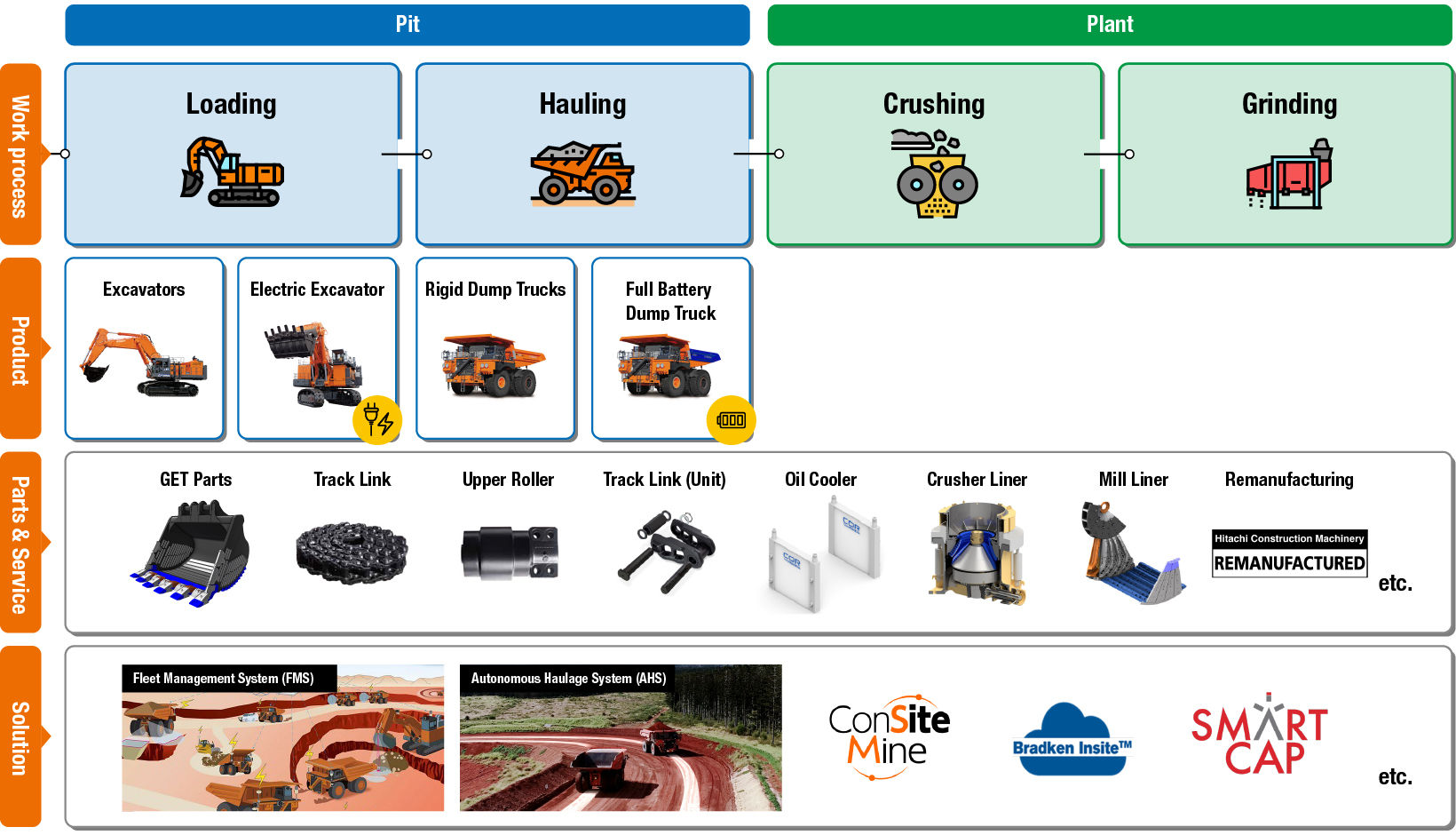
The Future of the Mining Business
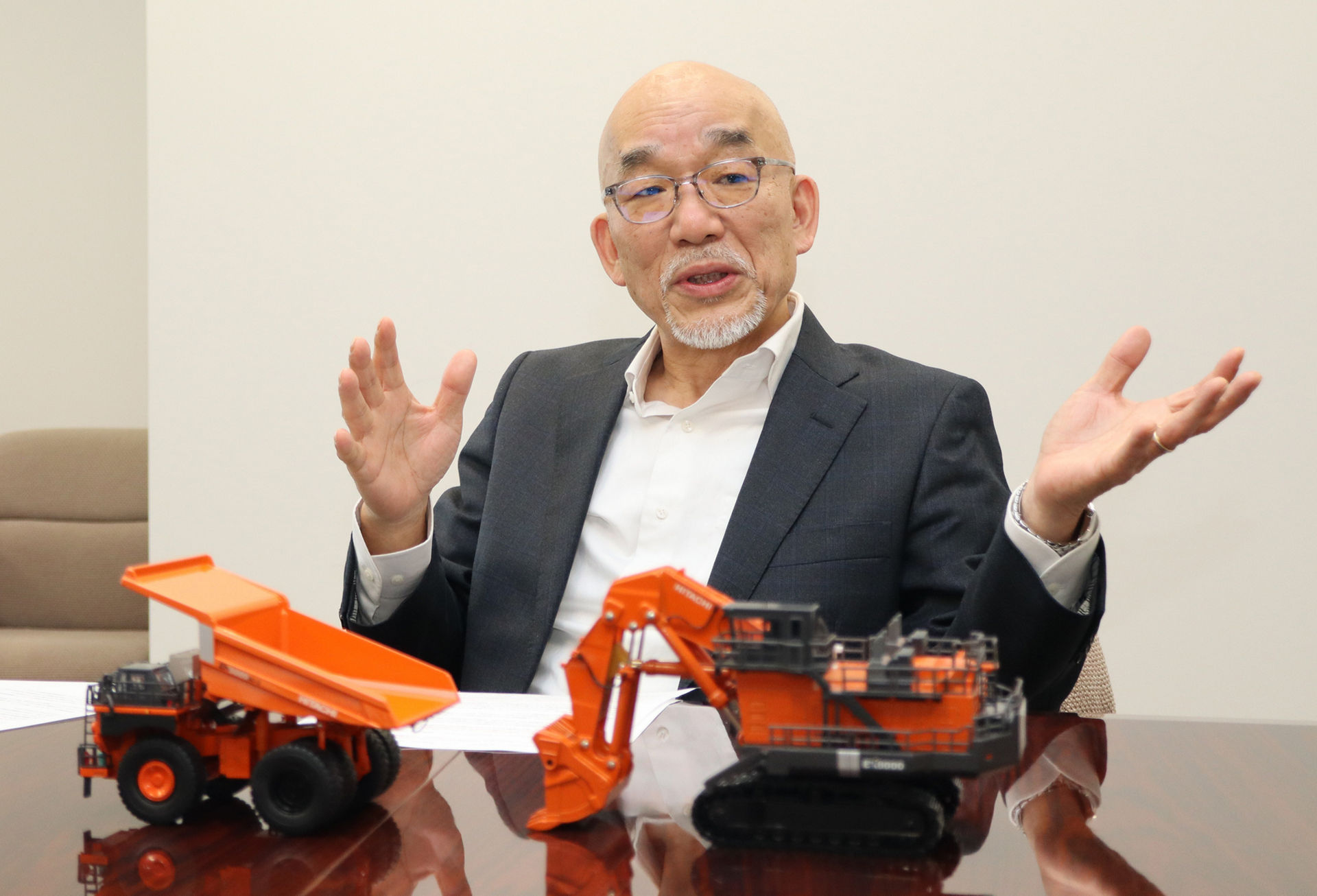
Hitachi Construction Machinery is working on reducing its CO2 emissions as we head toward the year 2050. What kind of specific actions are you considering?
In terms of products, we aim to reduce our Group-wide CO2 emissions by 22% by FY2025 and 33% by FY2030, based on FY2010 figures. This will involve the electrification of hydraulic excavators, the early market release of battery-operated rigid dump trucks, and research into the technical aspects of hydrogen fuel products and the utilization of synthetic fuels such as biofuels and e-fuels, which will enable reductions in the CO2 emissions of the engine-based construction machinery used by our customers.
In terms of production processes, we have set targets for reducing CO2 emissions across the entire Group by 40% by FY2025, and 45% by FY2030, and are promoting a switch to energy saving and renewable energy.
Could you please explain the challenges that may arise in the mining industry?
Looking ahead to the next two or three decades, there is concern that we will face dwindling recoverable reserves of easily-accessible mining sites, as well as reduced quality of mined materials. We expect that mining will increase in sites subject to harsh environmental conditions, such as those deep within the earth or on the ocean floor. This will require sustainable development and usage methods that take into account environmental conservation, the prevention of water pollution, and the needs of local communities. I believe we will also need to consider other initiatives for generating new value, such as rehabilitating discontinued mines via reforestation and stabilization, and the possible use of such sites as resources for tourism.
As we face such challenges, I hope that we can strengthen cooperation not only with our customers but also with partner companies, and thereby deliver innovative solutions that meet the needs of the new age.




